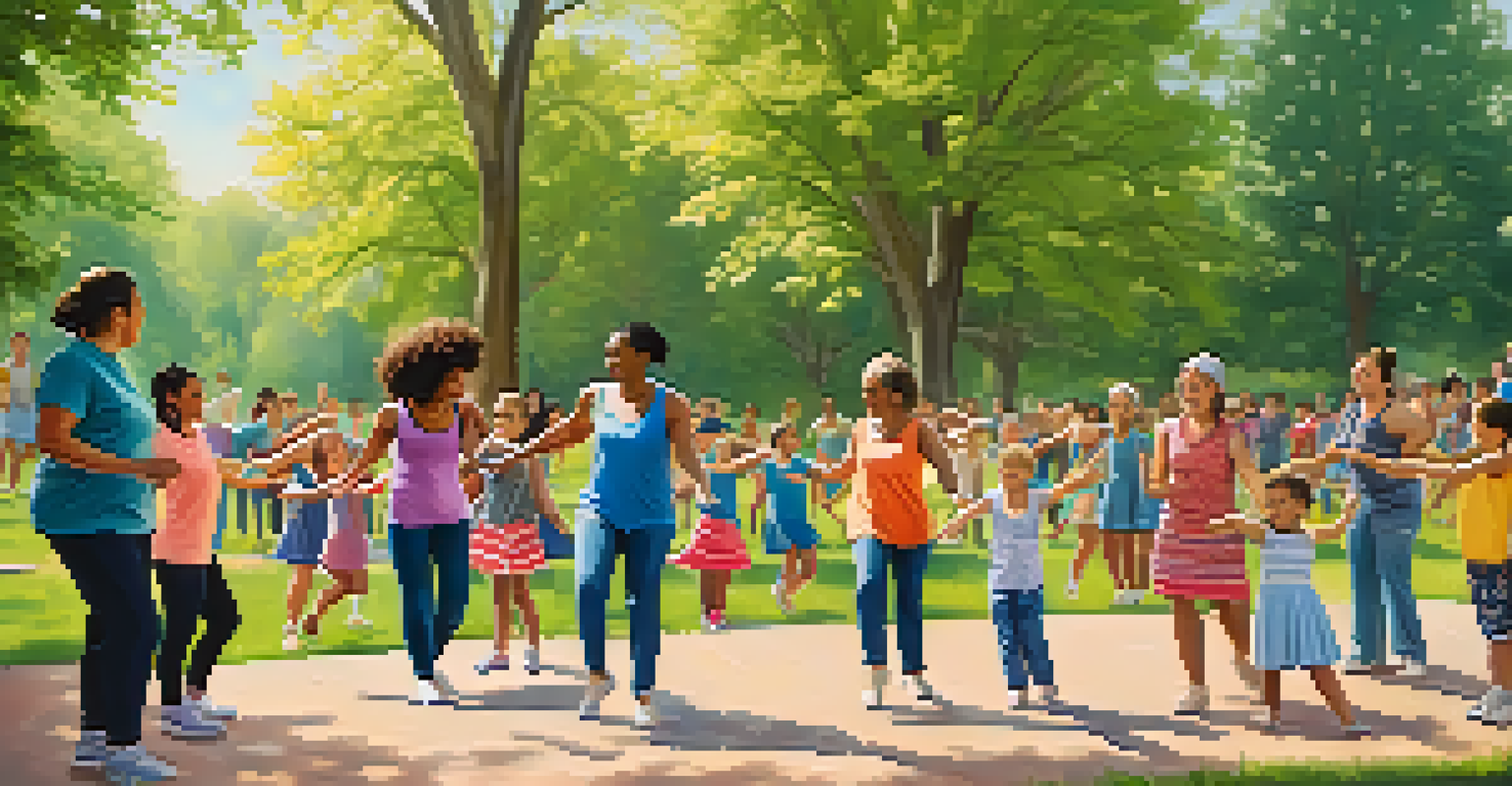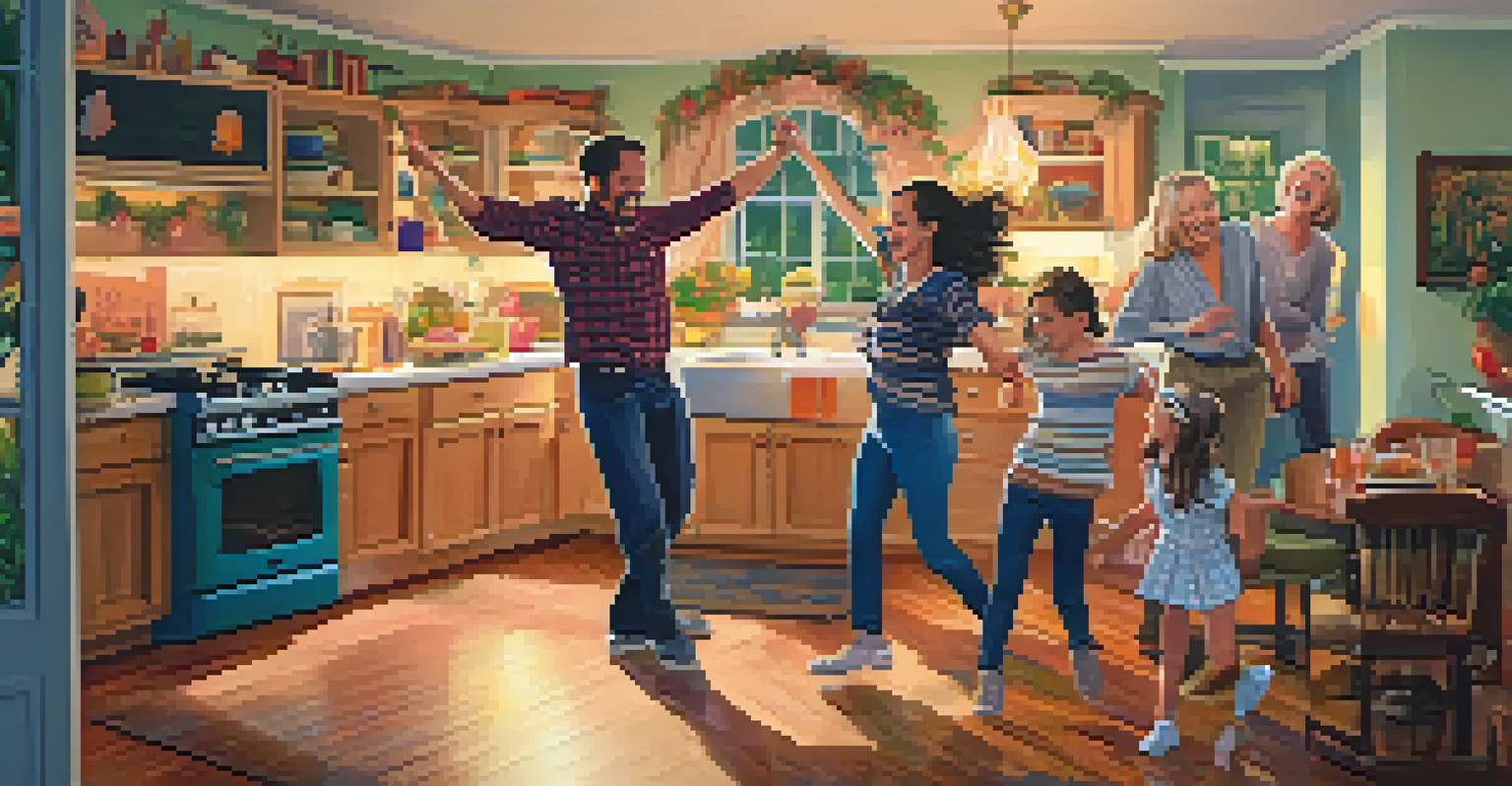The Therapeutic Benefits of Dance in Family Dynamics

Understanding Dance as a Therapeutic Tool
Dance is more than just a form of entertainment; it’s a powerful therapeutic tool that can foster emotional and physical well-being. Engaging in dance encourages self-expression and can act as a release for pent-up emotions. Families can use dance as a way to connect with one another, creating a safe space to share feelings and experiences.
Dance is the hidden language of the soul.
The therapeutic benefits of dance stem from its ability to incorporate movement and rhythm, which are deeply tied to our emotional states. When families dance together, they create a shared experience that can lead to deeper understanding and connection. This shared joy can help alleviate stress and anxiety, allowing family members to bond over the simple act of moving together.
Moreover, dance can be an inclusive activity that welcomes family members of all ages and skill levels. Whether it’s a spontaneous living room dance party or a structured class, the act of dancing together can break down barriers and foster a sense of unity. Ultimately, dance serves as a reminder that the journey of connecting with one another can be joyful and liberating.
Building Trust and Communication Through Dance
Trust is a fundamental component of any healthy family dynamic, and dance can play a significant role in building it. When family members dance together, they must rely on one another for support and coordination, which naturally enhances trust. This physical connection can translate into improved emotional communication, allowing family members to feel more comfortable expressing their thoughts and feelings.

In dance, the ability to lead and follow is essential, mirroring the dynamics of family relationships. By practicing these roles in a supportive environment, family members can learn to appreciate each other's strengths and weaknesses. This mutual understanding fosters empathy, making it easier to navigate conflicts and challenges as a unit.
Dance Enhances Family Connection
Engaging in dance fosters emotional bonding and communication among family members, creating a joyful environment for self-expression.
Moreover, dance encourages non-verbal communication, which can be particularly beneficial in families where verbal expression is challenging. Through movement, families can convey emotions and messages that words might fail to express. This non-verbal dialogue can create a deeper emotional connection and understanding among family members.
Enhancing Emotional Regulation Through Movement
Emotional regulation is a crucial life skill, and dance can help families develop this ability in a fun and engaging way. When families dance, they not only express their feelings but also learn to manage them through movement. The physical activity involved in dancing releases endorphins, which can elevate mood and provide a natural outlet for stress.
The body says what words cannot.
For example, a family that dances together regularly may find that they are better equipped to handle tough situations, as they can channel their emotions through movement. This practice of expressing feelings physically can make it easier to talk about emotions later. In essence, dance becomes a tool for families to release tension and foster a more emotionally aware atmosphere at home.
Additionally, learning new dance styles or routines together can be a great way for families to challenge themselves and grow. The process of mastering new skills can build resilience and patience, essential components of emotional regulation. It’s a win-win: families bond while developing emotional intelligence.
Fostering Creativity and Individuality in Families
Dance is a beautiful expression of creativity, and engaging in it as a family allows each member to showcase their individuality. Every person has their unique style and rhythm, and dance invites families to celebrate these differences. This encouragement of self-expression can lead to increased self-esteem and confidence in both children and adults.
When families create their own dance routines or improvise together, they are not only having fun but also learning to appreciate one another's artistic choices. This shared creative process can lead to deeper conversations about identity and personal expression. Celebrating each person’s individuality fosters an environment where family members feel valued and understood.
Dance Builds Trust and Empathy
Through the physical connection of dance, families can cultivate trust and improve non-verbal communication, leading to deeper understanding.
Moreover, dancing can be a source of inspiration for other creative pursuits. Whether it’s drawing, writing, or even cooking, the joy and energy from dancing can spill over into other areas of family life. The act of creating together strengthens the family bond and encourages a culture of creativity and support.
Strengthening Family Bonds Through Shared Experiences
Shared experiences are vital for building strong family bonds, and dance provides endless opportunities for memorable moments. Whether it's attending a dance class or participating in a community performance, these activities create lasting memories that families can cherish. The laughter and joy experienced during these moments can become the foundation of family history.
Moreover, these shared experiences can serve as a break from daily routines, allowing families to escape the hustle and bustle of life. Engaging in dance together can be a refreshing way to reconnect and enjoy each other's company. It's during these moments that families often find opportunities to discuss important topics and share their dreams and aspirations.
Ultimately, the memories created through dance become stories that families tell for years to come. They serve as reminders of the fun and love shared within the family unit. By investing time in these shared dance experiences, families can cultivate a strong bond that withstands the test of time.
Promoting Physical Health and Well-Being in Families
In addition to its emotional benefits, dance is an excellent way for families to promote physical health and well-being. Dancing is a fun, dynamic workout that can improve cardiovascular health, flexibility, and coordination. When families engage in dance together, they are not only enjoying themselves but also investing in their physical fitness.
Participating in regular dance sessions can help combat sedentary lifestyles, especially for families who may spend much of their time in front of screens. Instead of opting for a movie night, families can dance in their living rooms, turning exercise into a joyous activity. This shift can help instill healthy habits in children from a young age.
Dance Promotes Holistic Well-Being
Participating in dance not only improves physical health but also enriches emotional and mental well-being, making it a comprehensive family activity.
Additionally, the physicality of dance can encourage families to explore different styles and traditions, enriching their cultural awareness. From salsa to hip-hop, each genre offers unique movements and rhythms, making the experience both educational and enjoyable. By promoting physical health through dance, families can create a holistic approach to well-being that includes emotional, mental, and physical aspects.
Creating a Lifelong Love for Dance and Movement
One of the most significant benefits of engaging in dance as a family is the potential to foster a lifelong love for movement. When families embrace dance as a regular activity, they lay the foundation for healthy habits that can last a lifetime. Children who grow up dancing are more likely to continue seeking out physical activities as they age.
This love for movement can also extend beyond dance, inspiring families to explore other forms of exercise and outdoor activities together. The joy of dancing can motivate family members to stay active, whether through sports, hiking, or even just walking together. It's a gift that keeps on giving, promoting health and happiness for years to come.

Moreover, as family members grow and change, dance can serve as a constant thread connecting them. No matter where life takes them, the memories of dancing together can evoke feelings of joy and togetherness. This lasting impact can help families maintain strong connections, even as they navigate the challenges of life.